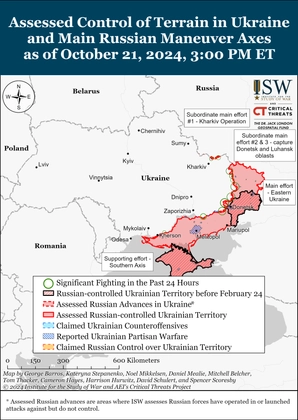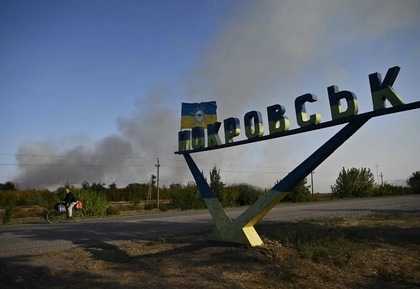From the editors: This is the third of a five-part analysis. See Part 1 and Part 2
here.
JOIN US ON TELEGRAM
Follow our coverage of the war on the @Kyivpost_official.
Drone warfare
The evolving drone war is changing how countries wage war. Drones allow you to see in a matter of minutes what conventional reconnaissance would take a couple of weeks to find out. It allows you to strike targets otherwise unattainable with conventional means. First-person view (FPV) “kamikaze” drones “are both highly maneuverable and exceedingly fast. They are also invulnerable to GPS jamming because they are hand-operated in real-time using their cameras. They are more difficult to intercept with anti-aircraft defenses because of their speed, relatively small size and high maneuverability.
Commercially available, inexpensive and easy to operate, these systems are more accurate than artillery or mortar fire. They can also carry payloads from hand grenades to antitank warheads which can be used to lethal effect against all but the most hardened of targets. The footage they produce also has significant value in the information war.” Drones worth hundreds of US dollars are destroying heavy equipment worth millions.
Drones have been involved in all significant battles during the full-scale war. “If you don’t have drones, you are fighting blind: the enemy can see you, but you can’t see them.”
Ukraine, a country without a Navy has so far destroyed 23 Russian warships, vessels and one submarine through the use of cruise missiles, UAVs and maritime drones. It has forced the Black Sea Fleet to relocate to mainland Russia, enabling more than 226 civilian vessels to enter Ukrainian ports since the end of the Black Sea Grain Initiative on July17. Ukrainian first-person view (FPV) drones are presently destroying more than 40 percent of Russian tanks and more than 30 percent of its armored vehicles, artillery, and trucks. Despite the fact that Ukrainian companies produce about 50,000 FPV drones every month, it is still only 10-15 percent of what is needed.

ISW Russian Offensive Campaign Assessment, October, 22, 2024
Russia is producing and importing far more. According to a Ukrainian expert, Maria Berlinska: “The Russians are way ahead of [Ukraine]. The more they automate their systems, the more they develop ‘drone swarms’ and automatic optical navigation (when the drone itself recognizes the target and makes the decision to hit it), when there are thousands of such drones flying, [Ukraine] will be forced to retreat dozens of kilometers in a matter of weeks.”
Both Ukraine and Russia are mobilizing both partners and their defense industrial base to gain a decisive advantage on the battlefield. The one that succeeds, will be able to fundamentally change the dynamics of the war. Maybe.
Reduced inflow of weapons and ammunition from the West is the result of flawed strategic thinking and failure to invest in security and defense
The psychological factor
Ukrainians are exposed to all war-related traumas. Ukraine had 851,068 veterans even before the full-scale war started. If the war was to end today, Ukraine would have an additional 1,800,000 veterans. If their families are included, a staggering 7,200,000 (or 10-20 percent of the total population) could need support because of trauma caused by fighting the war alone. Ukrainians are, however, fighting an existential war. Their high motivation is reflected on the battlefield and helps explain why it is defeating a superior force.
Russia has suffered losses not seen since World War II. According to US intelligence, the Russian army began the war with 3,100 tanks but lost 2,200 of them. It has been forced to “backfill” tanks, armored vehicles and artillery produced between 1950 and 1980. It has suffered at least 315,000 dead and injured soldiers. That is equivalent to nearly 90 percent of the personnel it had at the beginning of the full-scale invasion.
Russia has been trying to storm Ukrainian positions using human wave “tactics,” often without the support of artillery and armored vehicles. Due to its massive losses, it is at times forced to establish “barrier troops” to force the soldiers to move forward. Drunk recruits, insubordinate soldiers and convicts are being pressed into Russian penal units known as “Storm-Z” squads and sent to the frontlines in Ukraine as “cannon fodder.” Morale and motivation have hit rock bottom, recently forcing the commander of the Russian “Dnieper Group” to form assault units made up of officers. Lack of rotation will further aggravate the situation.
Russian forces might collapse and disintegrate they did during World War I. While it’s hard to predict if or when its breaking point will occur, it might very well happen in 2024. Forcing Russian Forces to assault Ukrainian fortified positions (e.g., Bakhmut and Avdiivka), suffering massive losses might help bring about the collapse. Maybe.
Defense aid
The media is often framing the reduced inflow of weapons and ammunition as a part of the so-called “Ukraine fatigue.” It is not. It is a result of flawed strategic thinking and failure to invest in security and defense. The West knew already last year that it lacked the stockpiles needed to provide Ukraine with what it needed to defeat Russia.
In August 2022, I warned that “NATO was running out of weapons with which it can supply Ukraine.” NATO members failed to mobilize their Defense Industrial Base (DIB), strengthen their Armed Forces, and build stockpiles of arms and ammunition when the war started in 2014. In April 2022, the US Defense Industry stated that it would need 18-36 months to ramp up production if it received the necessary defense procurement orders.
US defense aid to Ukraine will most likely resume next year simply because it is in its national interests. It helps reduce Russia militarily at minimum costs (to the US). It sends a signal of will and capability to all its potential opponents, deterring future conflicts. The effort helps expand and strengthen its DIB. Both old and new production lines are opened. Old weapons delivered directly from its Armed Forces are being replaced with new, modern equipment. Additionally, most of the costs are spent in the US, creating jobs. The US is also gaining invaluable, combat-tested insights into Ukrainian military technologies, countermeasures against drones, Russian military tactics and strategies for countering Russian electronic warfare. US aid to Ukraine is not an expense but a long-term strategic investment.
Europe will not be in a position to replace the defense aid provided by the USA. Three decades of underfinancing, downsizing, and streamlining have left Europe unable to provide Ukraine with the weapons and ammunition it needs. The countries urgently need to rebuild their own Armed Forces and sustainability. The European DIB is by no means producing what is needed, as reflected in its failure to deliver the 1 million artillery shells promised and pledges to provide Air Defence Systems in 2024 and 2025. Hopefully, the production rate will increase in the upcoming year. Maybe.
The Black Sea
Ukraine has had great success in the Black Sea.
The Russian Black Sea Fleet (BSF) has suffered several embarrassing losses and setbacks to a country without a Navy.
The BSF has been forced to relocate parts of its fleet away from Crimea. The threat of an amphibious landing in the south of Ukraine is gone. Its ability to build a maritime recognized picture is reduced. It has lost its flagship, some of its missile carriers, and a submarine. Its ability to block Ukrainian ports is reduced.
Ukraine has been able to reopen a shipping lane through the territorial waters of Romania, Bulgaria, and Turkey. Since Aug. 8, more than 200 ships have left the ports through the Ukrainian corridor set up by the Ukrainian Navy, and 226 ships have entered the ports as of Dec 4.
Russia has until now decided to not intervene and block the shipping lane. Being asked if Moscow is considering options to block this corridor, Foreign Ministry Spokeswoman, Maria Zakharova, avoided responding directly but instead alleged that the corridor is being used for military purposes, underpinning Russia’s statement on July 19 that “all ships proceeding to Ukrainian ports in Black Sea waters will be considered as potential carriers of military cargo,” implying that they would be viewed as legal targets.
While the Ukrainian success has been spectacular, the BSF and its Naval Air Wing maintain the ability to interdict and stop civilian shipping if they so desire. When Russia has refrained from doing just that, it is highly likely linked to its long-term objective of avoiding direct involvement in the war by the West. Sinking or damaging foreign-flagged vessels might do just that. Maybe.
Hans Midtunn………………………
The views expressed in this opinion article are the author’s and not necessarily those of Kyiv Post.
You can also highlight the text and press Ctrl + Enter






